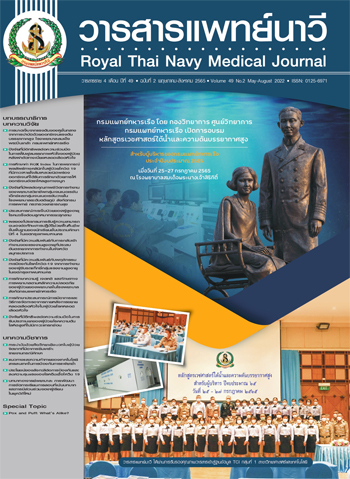Factors Affecting Quality of Work Life among Generation X and Y Nurses in a Tertiary Hospital under Department of Medical Services, Ministry of Public Health
Main Article Content
Abstract
The objective of this cross-sectional research is to study the quality of work life (QWL) of two different generations of nurses working in a tertiary hospital under the department of medical services, ministry of public health as well as factors related to QWL. Using a stratified random sampling method, a total of 300 registered nurses, 137 Generation X registered nurses and 163 Generation Y registered nurses, recruited as the sample of this study. Data were collected using a self - administered questionnaire comprising of five sections: 1) personal factors, 2) organizational commitment factors, 3) job satisfaction factors, 4) work environment factors, and 5) quality of nursing work life (QNWL). The content validity index of the questionnaires were 0.80 - 1 and reliability coefficients were 0.70 - 0.92. Data was examined using chi-square test, Pearson’s product-moment correlation coefficient, and Stepwise multiple regression.
This study showed that the quality of work life of Generation X and Y registered nurses was at a high level (Mean = 189.31, SD = 18.30; Mean = 188.31, SD = 18.56), respectively. The factors that had significant positive relationship with quality of nursing work life were salary, work environment, job satisfaction and organizational commitment. A significant negative relationship was found between work on weekend/holiday with QWL significantly at .01 level. We found that the best predictor of quality of work life were organizational commitment, job satisfaction, and work environment, they could explain 68.4% of variance in quality of work life (B = 4.75, 4.24, 3.38).
The results of the research will provide information for nursing and health policymakers to develop policies to improve QWL. To improve quality of work life and support multiple generations of nurses, nursing managers need to consider the job satisfaction, create organizational commitment and work environment.
Article Details

This work is licensed under a Creative Commons Attribution-NonCommercial-NoDerivatives 4.0 International License.
References
Kittisuksathit S, Chamchan C, Tangchonlatip K, Holumyong C. Quality of life, work and happiness. Bangkok: Thammada Press; 2012. (in Thai).
Brook BA, Anderson MA. Difining quality of nursing work life. Nurs Econ 2005;23(6):319-26.
The Institute for Population and Social Research Mahidol University. Thai health 2016. Bangkok: Amarin Printing & Publishing 2016:8-108. (in Thai).
Green AP, Eigel LM, James JB, Hartmann D, Mclean KM. Multiple generations in the workplace: exploring the research, influence of stereotypes, and organizational applications. New York: Oxford University press; 2012. p. 483-500.
Kaewsasri A, Nilliaum R, Heetaksom C. Changes in Thai society and culture and trends of nursing professional. Songklanagarind Journal of Nursing 2017;37(3):160-9. (in Thai)
Sawaengdee K. Crisis of nursing shortage in health service facilities under office of permanent secretary, ministry of public health. J Health Sci 2017;26(2):456-68. (in Thai).
Suttharat S. Relationships between work environment, leadership of head nurse, and organizational commitment of generation Y professional nurses, autonomous university hospital. Journal of The Police Nurse 2015;7(1):238-252. (in Thai).
Dechwatanapasal D, Numphaya K, Nualuk J, Pleumbun C. A sduty of viewpoints and expactations of generational characteristic between Generation X and Generation Y. Chulalongkorn Business Review 2014;36(3):1-17. (in Thai).
Chanaken W. Factors influencing work retention of generation Y profession nurses at a tertiary level hospital in the department of medical service under the ministry of public health. [Master’s Thesis, Faculty of Nursing]. Christian University of Thailand; 2016. (in Thai).
Junyatham S. Suwannapong N, Tipayamongkholgul M, Aimyong N. Quality of work life of professional nurses in one public university hospital. Royal Thai Navy Medical Journal 2018;45(1):52-62. (in Thai).
Akter N, Akkadechanunt T, Chontawan R. Feactors predicting quality of work life among nurses in tertiary-level hospital, Bangladesh. Int Nurs Rev 2017;65(2):182-9.
Thakre SB, Thakre SS, Thakre SN. Quality of work life of nurses working at tertiary health care institution: a cross sectional study. International Journal of Community Medical Public Health 2017;4(5):1627-36.
Rajavithi Hospital. Nursing data and hospital data. [Internet]. [cited 2018 July 12]. Available from: http://rajavithi.go.th. (in Thai).
Almaki JM, FitzGerald G, Clark M. Quality of work life among primary health care nurses in the Jazan Region, Saudi Arabia: a cross-sectional study. Hum Resour Health 2012;10(30):1-13.
Parveen M, Maimani K, Kassim NM. Quality of work life: the determinants of job satisfaction and job retention among RNs and OHPs. International Journal of Emergency Mental Health and Human Resilience 2016;18(2):742-51.
Anand VV, Vijayabanu C, Badrinath V, Renganathan R. Quality of work life of employee in private hospital: a study by applying multiple regression analysis. Int J Pure Appl Math 2018;119(7):2765-75.
Chinnawoot S, Uraisripong K, Wongjan J. Factors related to quality of work life among nurses: a systematic review. Nursing Journal of the Ministry of Public Health 2020;30(3):90-103. (in Thai)
Brook BA, Omoike O, Stemler I, Brown, A. Assessing the quality of nursing work life. Nurs Admin Q 2007;31(2):152-7.
Daniel W. Biostatistics: foundation for analysis in the health sciences. 8th ed. New York: John Wiley & Sons; 2014.
Lake ET. Development of the practice environment and scale of the nursing work index. Res Nurs Health 2002;25(3):176-88.
Meyer JP, Allen NJ. A three-component conceptualization of organizational commitment. Hum Resource Manag Rev 1991;1(1):61-89.
Jaros S. Meyer and Allen model of organizational commitment measurement issues. The lcfai Journal of Organizational Behavior 2007;6(4):7-25.
Mueller CW, McCloskey JC. Nurses’s job satisfaction: a proposed measure. Nurs Res 1990;39:113 -7.
Tourangeau AE, McGill Hall L, Doran DM, Petch P. Measurement of nurse job satisfaction using the McCloskey/Mueller satisfaction scale. Nurs Res 2006;55(2):128-36.
Keawpan W, Kalampakorn S, Sillabutra J, Jirapongsuwan A. Development of intermediate and long term care model for dependent elderly by enhancing competency and employment of retirement nurses as care manager. Bangkok: Metta Printing; 2021. (in Thai)
Coburn AS, Hall SJ. Generation difference in nurse characteristics, job satisfaction, quality of work life, and psychological empowerment. J Hosp Admin 2014;3(5):124-34.

